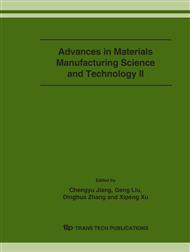p.436
p.440
p.444
p.448
p.452
p.456
p.460
p.464
p.468
Study of the Removing Depth of the Polishing Surface Based on a Novel Spinning-Inflated-Ballonet Polishing Tool
Abstract:
In the field of the mold-curved free surface polishing, how to control the removing depth of the polishing surface exactly is one of the important problems to be solved. In this paper, a mould automatic polishing system that is developed on Motoman-NL20 robot is used to make theoretical analysis and experimental research on the removing depth of the polishing surface based on a novel Spinning-Inflated-ballonet Polishing tool for curved surface of mould. Firstly, FEM (finite element analysis) software is used to emulate three kinds of situation in the process of polishing, then the model of surface removing depth of SBCT polishing is established. At last, through the analysis and comparison, the result of emulation and experiment has a remarkable consistency which accords with the model established by formal theory. This indicates the correctness of the model.
Info:
Periodical:
Pages:
452-455
Citation:
Online since:
December 2006
Keywords:
Price:
Сopyright:
© 2006 Trans Tech Publications Ltd. All Rights Reserved
Share:
Citation:


